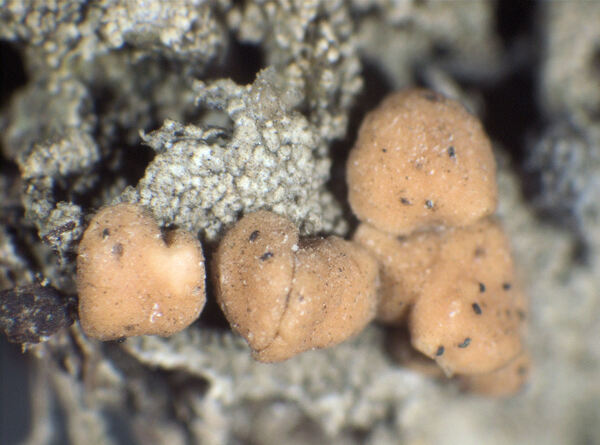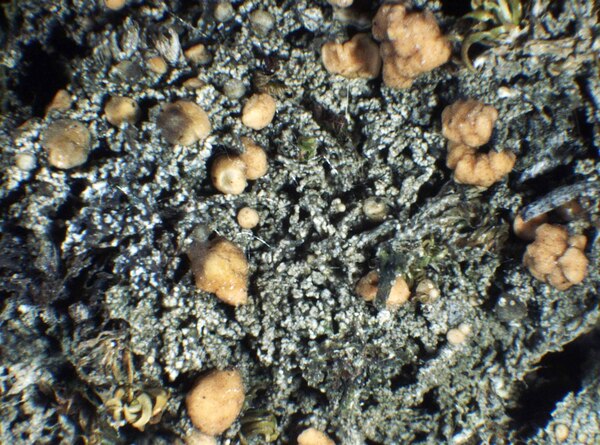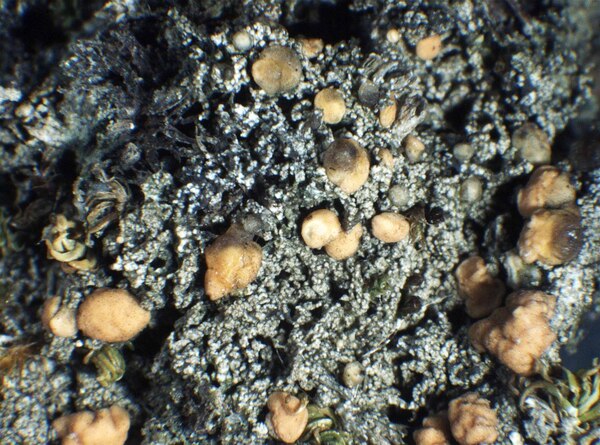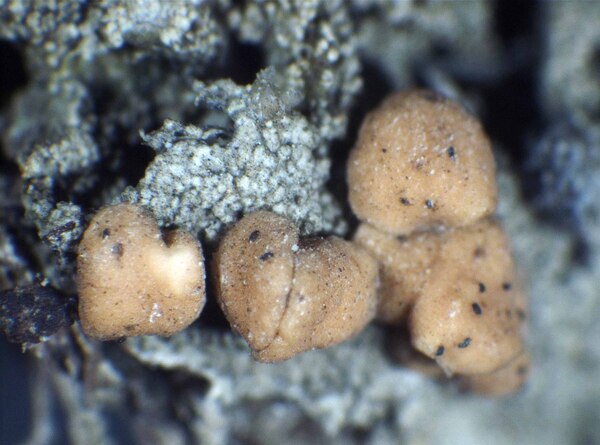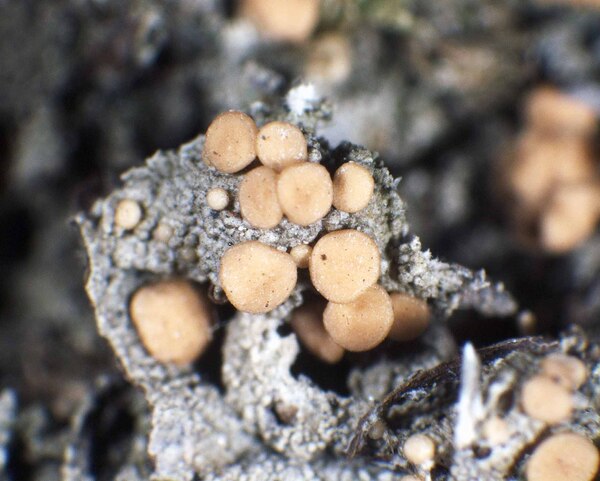Bacidina subfuscula (Nyl.) S. Ekman
Nordic J. Bot.: e03846, 39, 2023. Basionym: Lecidea subfuscula Nyl. - Flora, 48: 604, 1865.
Synonyms: Bacidia subfuscula (Nyl.) Th. Fr.; Lecania subfuscula (Nyl.) S. Ekman
Description: Thallus crustose, very variable, from immersed or filmy to (usually) granular-warted, greenish white to pale brown. Apothecia biatorine, crowded into clusters, 0.2-0.6 mm across, with an initially flat, but soon becoming convex, grey-brown pinkish brown to black disc, and a thin, usually paler proper margin. Proper exciple brown and K+ purple along the upper outer edge and at the top, otherwise colourless, of radially arranged, cellular hyphae; epithecium colourless to olivaceous grey or violet-brown, N+ red, K+ purple when strongly pigmented; hymenium colourless or with brownish vertical strikes in upper part, 40-50(-65) μm high; paraphyses rather lax, 1.5-2 µm thick, the apical cells swollen, up to 5 µm wide, usually brown-pigmented; hypothecium colourless or yellowish, the pigmented parts K+ pale yellow. Asci 8-spored, clavate to cylindrical-clavate, the apical dome K/I+ dark blue with a pale, conical-pointed apical cushion (axial mass) never penetrating through the entire d-layer, the wall K/I-, but the thin outer gel K/I+ blue, Bacidia-type. Ascospores 3(-5)-septate, hyaline, bacilliform, 14-28 x 2-3 µm. Pycnidia immersed, with a colourless wall. Conidia partly curved, 30-55 x 1-1.5 µm. Photobiont chlorococcoid. Spot tests: thallus K-, C-, KC-, P-, UV-. Chemistry: thallus without lichen substances.
Growth form: Crustose
Substrata: soil, terricolous mosses, and plant debris
Photobiont: green algae other than Trentepohlia
Reproductive strategy: mainly sexual
Commonnes-rarity: (info)
Alpine belt: very rare
Subalpine belt: very rare
Montane belt: extremely rare
Dry submediterranean belt: extremely rare
Humid submediterranean belt: absent
Padanian area: absent
pH of the substrata:
1 2 3 4 5
Solar irradiation:
1 2 3 4 5
Aridity:
1 2 3 4 5
Eutrophication:
1 2 3 4 5
Poleotolerance:
0 1 2 3
Altitudinal distribution:
1 2 3 4 5 6
Rarity
absent
extremely rare
very rare
rare
rather rare
rather common
common
very common
extremely common
Loading data...
Occurrence data
Predictive map
Growth form: Crustose
Substrata: soil, terricolous mosses, and plant debris
Photobiont: green algae other than Trentepohlia
Reproductive strategy: mainly sexual
Commonnes-rarity: (info)
Alpine belt: very rare
Subalpine belt: very rare
Montane belt: extremely rare
Dry submediterranean belt: extremely rare
Humid submediterranean belt: absent
Padanian area: absent
pH of the substrata:
| 1 | 2 | 3 | 4 | 5 |
Solar irradiation:
| 1 | 2 | 3 | 4 | 5 |
Aridity:
| 1 | 2 | 3 | 4 | 5 |
Eutrophication:
| 1 | 2 | 3 | 4 | 5 |
Poleotolerance:
| 0 | 1 | 2 | 3 |
Altitudinal distribution:
| 1 | 2 | 3 | 4 | 5 | 6 |
Rarity
absent
extremely rare
very rare
rare
rather rare
rather common
common
very common
extremely common
Loading data...
Occurrence data
Predictive map


